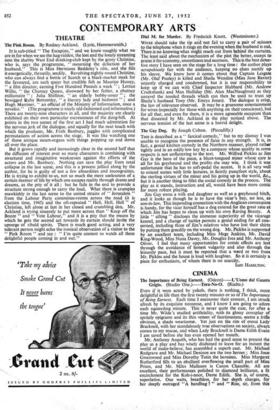CINEMA
The Importance of Being Earnest. (Odeon)—L'Uomo dal Guanto Grigio. (Studio One.)—Tora-No-0. (Rialto.) EVEN if it were acted by yokels, there is nothing, I think, more delightful in life than the first twenty minutes or so of The Importance of Being Earnest. Each time I encounter their content, I am struck afresh by its exquisite nonsense, and I know I am going to adore each sq.cm. eding minute. This is never quite the case, for after a time Mr. Wilde's studied artificiality, with its glossy crossplay of spritely epigrams and its thin veneer of facetiousness, seems a trifle obvious, a shade wearisome. Yet just on the rim of ennui Lady Bracknell, with her scandalously true observations on society, always comes to my rescue, and when Lady Bracknell is Dame Edith Evans I am saved before she has even opened her mouth.
Mr. Anthony Asquith, who has had the good sense to present the play as a play and has wisely disdained to leave for an instant the world of make-believe, has assembled a superb cast. Mr. Michael Redgrave and Mr. Michael Denison are the two heroes ; Miss Joan Greenwood and Miss Dorothy Tulin the heroines. Miss Margaret Rutherford fills to an ebullient overflowing the small part of Miss Prism, and Mr. Miles Malleson is Canon Chasuble. All are excellent, their performances polished to diamond brilliance, a fit encirclement for the Koh-i-noor, Dame Edith. She is, of course, superlative. One waits, breathless, for her depth charges, for her deeply outraged "A handbag " and " Rise, sir, from this semi-recumbent posture ! " and they blow one up to heaven as one knew they would.
In this sleek Technicolored rendering of what is so nearly the perfect satirical comedy in English drama I have only one fault to find, and this is in the clothes. They are, I feel, too grotesque, the dresses too bespangled, the hats too feathered. Resplendency is all very well, but it should be becoming rather than outrageous.
An Italian thriller is somewhat unexpected, but there is nothing particularly original about L' Como dal -Guanto Grigio, though it is a slick workmanlike film and by no means to be despised. Its story centres on a stolen picture, and involved in this masterpiece's conceal- ment or recapture are a handsome art-dealer with greying temples living in a baroque palace, a drunken picture cleaner living in a garret with a bottle, a young tenor who sings far too many arias and is always arresting the plot by his vocalising, and a lady art-student whose dilssical features are capped in top-heavy undulations by mountainous seas of blonde hair. Deftly directed by Signor Camillo Mastrocinque, the film runs through a succession of mysterious murders with well-oiled competence, and ends up in splendid alarm, grey-gloved hands reaching for the heroine's throat in a dungeon full, apparently, of Benvenuto Cellini salt-cellars.
Tora-No-O, directed by Mr.' Akira Kurosawa, the director of Rashomon, is a Japanese legend telling of how a young mediaeval lord, pursued by his brother, is helped to escape by six trusty followers disguised as priests, and by a buffoonish porter. Unlike its prede- cessor, it is as still as an oriental screen, a series of watercolour tableaux set in misty trees with bird-calls as accompaniment ; inscrutable faces crowned with matchbox hats, slow gestures and weird intonings. Suspense is built up almost by the eyes alone, which, in the long silences, speak from impassive brows with more than verbal clarity. Though largely immobile, these Japanese actors can make violent dramatic impact. Indeed it is only when, as in the case of the porter, drama is interpreted by vaudeville grimaces that it ceases to be effective. The film is short, which is another point to its advantage ; a shOrt, strange, fascinating morsel



































 Previous page
Previous page